

 Knowledge Base +
Knowledge Base +  2023.12.01
2023.12.01A Quad Small Form-factor Pluggable (QSFP) is a high-speed compact and hot-pluggable transceiver used for data communication applications. It is commonly used in data center and telecommunication environments for high-speed networking, such as Ethernet, fiber channel, and InfiniBand applications.
A QSFP transceiver works by converting electrical signals into optical signals for transmission over fiber optic cables, and then converting the received optical signals back into electrical signals for the receiving end. It contains four channels of transmitters and receivers, allowing for high-speed data transmission.
The QSFP transceiver uses a MPO/MTP interface for connecting to fiber optic cables, and can support various data rates and communication protocols, such as 40 Gigabit Ethernet, 100 Gigabit Ethernet, and InfiniBand.
Overall, QSFP transceivers are essential components for high-speed data communication and networking, providing a compact, high-density, and high-speed solution for data center and telecommunication applications.
In the data center, various types of optic module transceiver are seen everywhere, such as SFP, SFP+, XFP, SFP28, QSFP/QSFP+, CFP and QSFP28. However, for those who get in touch with them for the first time, just like me, maybe most information, is unfamiliar to them. Fortunately, I have right collected some materials about them some time ago. Today, I want to share it here in the form of comparison to help those who need them.
What is SFP Connector?
SFP connector or SFP plug is another name of SFP as SFP (small form-factor pluggable) is a compact and hot-pluggable interface connector. The SFP connector module functions as the intercommunication media between the network devices and cables to achieve photoelectric and electro-to-optical conversion. SFP interface is commonly used in SFP port network equipment such as Ethernet switches, firewalls, routers, network interface cards (NICs) for both data communication and telecommunication applications.

Figure 1: direct connection for 1000BASE-SX SFP connector modules with Ethernet switches and fiber optic patch cables. The SX connector SFP with a duplex SFP LC connector is for connecting multimode fiber for short-range application.
What is GBIC?
GBIC (Gigabit Bit Rate Interface Converter)
Until 2000, GBIC was the most popular optical module package and the most widely used form of Gigabit module.GBIC is an interface device that converts Gigabit electrical signals into optical signals.GBIC is designed to be hot-swappable.
GBIC modules are divided into two categories: first, GBIC modules are used in cascade to realize common connection with other switches; second, GBIC modules are dedicated to stacking to realize redundant connection with other switches.
What is SFP?
SFP, Small Form-factor Pluggable, is a small, hot-swappable optical module.SFP is half the size of a GBIC module and can be configured with more than twice the number of ports in the same panel.Functionally, there is not much difference between the two, and they both support hot-swapping.The maximum bandwidth supported by SFP is 4Gbps.
What is SFP+?
SFP+ is an enhanced version of SFP that supports 8Gbit/s Fibre Channel, 10G Ethernet, and the optical transport network standard OTU2. In addition, SFP+ direct connect cables (i.e., SFP+ DAC high-speed cable and AOC active fiber optic cables) connect two SFP+ ports without the need for additional optical modules and cables (network cables or fiber patch cords), making it a good choice for short-range networks with two adjacent ports. This is a good choice for directly connecting two switches that are in close proximity to each other.
What is SFP28?
SFP28 is an enhanced version of SFP+ with the same dimensions as SFP+ but capable of supporting a single channel of 25Gb/s. SFP28 provides an efficient solution for 10G-25G-100G network upgrades to meet the continued growth of next-generation data center networks.
What is QSFP?
QSFP, known as Quad Small Form-factor Pluggable, is a four-channel small form-factor pluggable optical module with four independent full-duplex transceiver channels. Originally designed to replace single-channel SFPs with high-density optical modules, the QSFP is only 30% larger than a standard SFP module. The device supports rates from 100Mbps to 10Gbps and, like the SFP, has digital diagnostics to monitor link performance.
Developed for high-density applications, the QSFP's four-channel pluggable interface achieves 40Gbps transmission rates and is used as a fiber optic solution that outperforms the 4-channel CX4 interface in terms of speed and density.
What is QSFP+?
QSFP+ is an upgraded version of QSFP. QSFP can support 4 channels of transmission at the same time, each with a data rate of 1Gbit/s. However, QSFP+ is different from QSFP in that it supports 4 x 10Gbit/s transmission channels, which enables 40Gbps transmission rates through 4 channels. Compared with SFP+, the transmission rate of QSFP+ optical modules can be up to four times that of SFP+ optical modules. QSFP+ optical modules can be directly used in 40G network deployment, increasing port density while effectively saving costs.
What is QSFP28?
The QSFP28 is designed to meet the needs of 100G applications with four high-speed differential signaling channels, each ranging from 25Gbps to potentially 40Gbps for 100G Ethernet (4 x 25Gbps) applications. 25G branch links or 100G to 2 50G branch links.
SFP VS SFP+
Simply put, SFP+ is an enhanced version of SFP . SFP usually supports 1.25 Gbit/s to 4.25 Gbit/s, while SFP + supports data rates up to 10 Gbit/s . For SFP and SFP +, they have the same size and appearance, but use different standards, SFP is based on IEEE802.3 and SFF-8472.
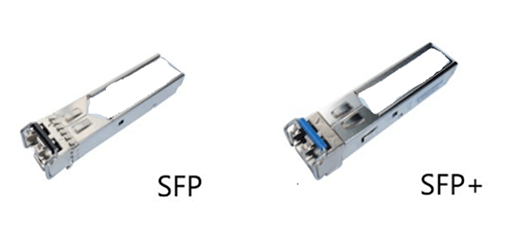
SFP+ vs XFP
Compared to earlier XFP modules, SFP+ is significantly smaller than XFP due to the fact that SFP+ saves PCB area by moving some of the functionality to the main board of the device rather than inside the module. These functional circuits mainly include signal modulation functions, MAC, CDR, and EDC. XFP is based on the XFP MSA standard, while SFP+ complies with IEEE 802.3ae, SFF-8431, and SFF-8432 protocols.
SFP+ vs QSFP+
QSFP+ is an interface with four channels of SFP + that can transmit up to 40Gbps. Again, they are based on different standards.
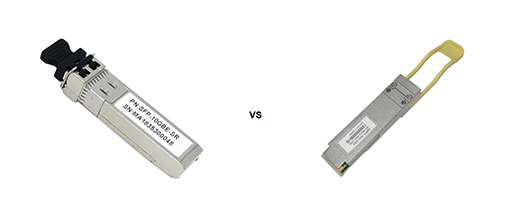
SFP28 vs SFP+.
SFP28 and SFP have the same structural definition and interface standards, except that SFP28 rate reaches 25Gbps, and the transmission efficiency is 2.5 times higher than that of SFP+. At present, 40G optical module and 100G optical module price is too high, power consumption is too large, and 10G optical module rate can not meet the network demand, so 25G SFP28 optical module just to make up for the shortcomings of the three. At the same time in 5G communications, SFP28 modules will be used in a large number of pre-transmission networks.
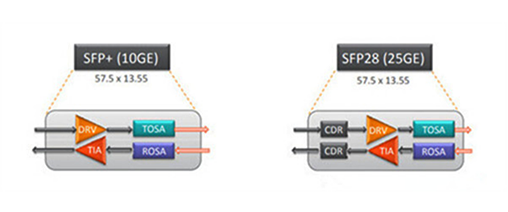
QSFP28 and CFP are both used in 100G Ethernet, but QSFP28 volume is less than a quarter of CFP, so under the same conditions, the plug density is significantly improved. Therefore, QSFP28 is the mainstream solution for 100G applications.
SFP28 vs QSFP28
SFP28 and QSFP28 transceivers use different sizes and operating principles. SFP28 supports only one 25 Gbit/s lane, while QSFP28 supports 4 independent lanes, each at 25 Gbit/s. Both can be used in a 100G network, but SFP28 is used in the SFP28 distribution scheme as QSFP28.
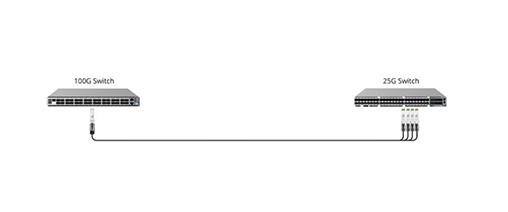
QSFP+ vs QSFP28
QSFP+ and QSFP28 transceivers integrate 4 transmit channels and 4 receive channels of the same size. In addition, both QSFP+ and QSFP28 product series include transceiver modules and DAC/AOC cables, but the speed differs. QSFP+ modules support 1x 40 Gbit/s and QSFP+ DAC/AOC cables support 4x 10 Gbit/s. QSFP28 modules are capable of transmitting data at 100 Gbit/s, and QSFP28 DAC/AOC cables can operate at 4x 25 Gbit/s or 2x 50 Gbit/s. Note that generally, QSFP28 modules cannot break through 10G links. But if the switch supports it, inserting a QSFP+ module into a QSFP28 port is another case. In this case, QSFP28 can break out to 4x10G like QSFP+ transceiver modules.

How to Choose SFP Transceivers?
In addition to SFP, SFP+, SFP28, QSFP+, and QSFP28, you also need to consider the application. Different types of SFP transceivers depend on their purpose, such as single-mode versus multimode SFP. Single-mode SFP transceivers work with single-mode fiber, while multimode SFPs are compatible with multimode fiber. In addition, there are long-reach WDM SFP transceivers for multiplexing, simplex SFPs for single-fiber applications, video SFP transceivers for transmitting high-definition video, and PON SFPs for fiber-based access network transceivers. SFPs are available in commercial and extended operating temperature ranges, with or without extended diagnostics.
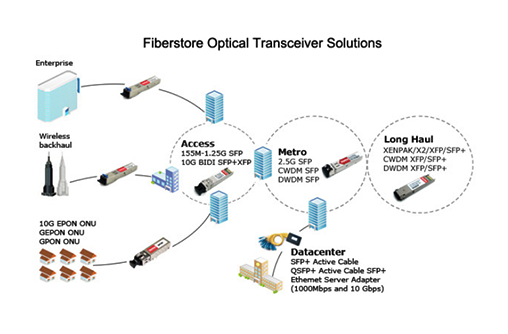
Subscribe to the newsletter
for all the latest updates.
2-5# Building, Tongfuyu Industrial Zone, Aiqun Road, Shiyan Street, Baoan District, Shenzhen. China
